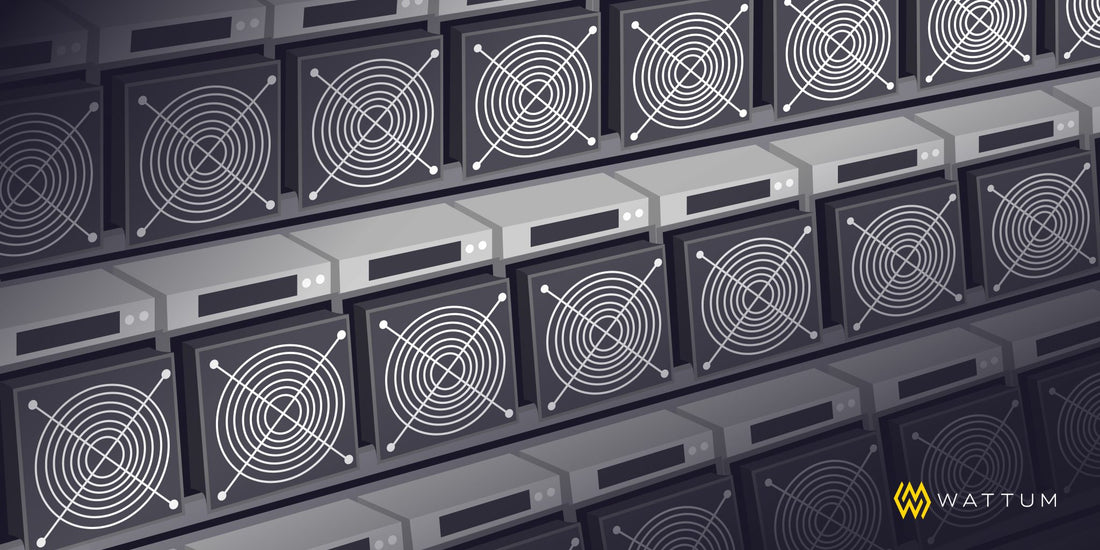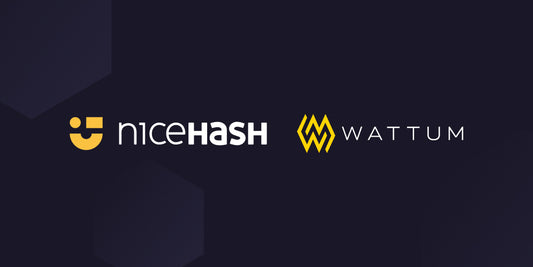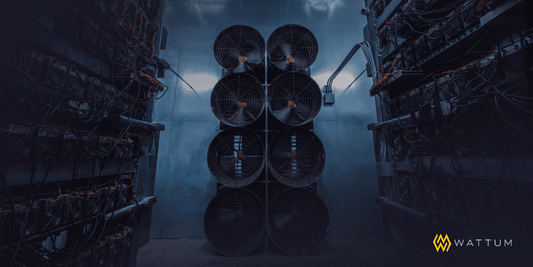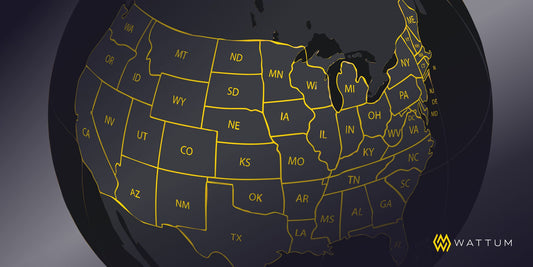It’s important to understand the methodology behind the pricing of mining hardware in order to determine if the purchase price of your Bitcoin mining equipment is fair. This also helps with understanding how the industry as a whole sets its pricing. Before we dive into the details, let’s brush up on the fundamentals and start off with the star of the show - an ASIC miner.
What is an ASIC?
An ASIC is an application-specific integrated circuit (a chip designed for a particular use) that is only meant to do one task, as opposed to being suitable for general use. When it comes to Bitcoin mining, the one and only use case for a Bitcoin ASIC is to mine Bitcoin. That is what it's specifically built for. Nothing else. Think of it as a computer that can only do one task (a one-trick pony, if you will). Now that we’ve established what a Bitcoin ASIC is, let’s circle back to Bitcoin mining.
In its simplest form, Bitcoin mining is the process of contributing your ASICs’ computational power to the Bitcoin network and getting rewarded for it with a fraction of a Bitcoin, also known as a block reward. The more computational power your ASIC has, the more it can contribute to the network; the more it contributes, the higher the reward; and the more Bitcoin you earn. This computational power is known as “hashrate”, and in today's ASIC units, it’s measured in terahashes per second, commonly referred to as TH/s on those complex-looking spec sheets. Below are some hashrate denominations for your reference:
1 MH/s is 1,000,000 hashes per second.
1 GH/s is 1,000,000,000 hashes per second.
1 TH/s is 1,000,000,000,000 hashes per second.
1 PH/s is 1,000,000,000,000,000 hashes per second.
ASIC miners have come a long way since their initial debut about a decade ago, and with each new generation have become more powerful. It is necessary for ASIC manufacturers to continue improving their miners' performance, and it's not just out of a desire to create a more powerful product - it’s required by the nature of Bitcoin mining itself. The reality of mining for Bitcoin is that the mining difficulty continues to increase, and the more people that mine, the harder the difficulty gets. Add in the fact that there are a finite amount of Bitcoins that can be mined, 21 million to be exact, and you’ve got another factor contributing to the ever growing mining difficulty. To put things into perspective, 19 out of the 21 million Bitcoins have already been mined in just over a decade, although it is estimated that the last Bitcoin won’t be mined until the year 2140. This goes to show how much the mining difficulty has spiked, and how much the block rewards have shrunk, thus constantly requiring a new and more powerful generation of Bitcoin ASICs to be purchased and put online, outperforming those of the previous generation.
What determines a Bitcoin ASIC’s value?
There are several factors that determine the overall performance of ASIC miners, and those factors include its power consumption (or efficiency) and its TH/s output (hashrate). Undoubtedly, an ASIC’s TH/s output is the main factor that everything is based off of, and it’s primarily the TH/s output that the price is tied to in this industry. In fact, the price you pay is the price paid per Terahash. In other words, the price you pay isn’t for the hardware itself, but rather for the level of performance you get out of it. There are several ASIC manufacturers on the market today, but unlike traditional consumer electronics, it isn’t so much about who manufactures the ASIC as it is about the ASIC’s performance and efficiency, which, again, is based on its total power consumption and TH/s output. While individual units produced by different manufacturers do have minor differences, they almost always come with similar manufacturer warranties (usually 12 months) and serve the same purpose: to mine for Bitcoin. The only thing that sets them apart is their performance and efficiency, negating any other differences that may cause someone to favor one manufacturer over another.
The reason TH/s matters most when purchasing ASICs in this industry is further demonstrated by various Bitmain S19 models. If you were to look up S19 units on AsicMinerValue.com, you would see various S19 units, including S19 Pro models, which usually have a higher hashrate output. The paradox here is that, in some cases, the lower TH/s units actually end up being more profitable because they consume significantly less power than the higher TH/s Pro model, and are also priced lower. So, as you can see, what ultimately matters most is the price per TH/s. Knowing the price per TH/s will help you determine whether it’s better to get a 95 TH/s unit for X amount of money, or a 104 TH/s unit for more. In fact, when Wattum orders ASICs from Bitmain, we prepay for a total aggregate hashrate; when we order a large quantity of 100 TH/s units, the shipment we receive often consists of some combination of 100 TH/s units, some 104 TH/s units, and some 96 TH/s units, but their combined output still averages out to 100 TH/s as ordered. This is how the industry operates. Such differences in hashrate output are oftentimes not intended by design, but rather are a case of silicon lottery. This simply means that the chip yield isn’t always the same, and some chips perform better or worse than others due to manufacturing defects. Further, those chips that cannot reach advertised speeds are sold under a different ASIC model rather than being discarded, hence why there are so many different models available.
Here at Wattum, while we generally do prefer units from Bitmain and MicroBT for their popularity and ease of resale on a secondary market, there is still very little difference between different manufacturers (as they’re all made to do one thing, and usually use the same chip manufacturer to build their computer chip components), so it’s helpful to think of them in terms of desktop computers with the same internal components, just manufactured by different brands, like DELL or HP (yes, there are minor differences, but as long as both computers have the same specs and hardware components, they will also perform about the same).
As ASICs are considered computer equipment, they can be depreciated in full over a 1-5 year period. In the year you purchase the equipment, their acquisition cost can be deducted. In the year you place the equipment in service, any remaining cost can either be depreciated with a special depreciation allowance, if considered qualified property, or it can be depreciated over a 5-year recovery period. Equipment itself typically depreciates due to the hardware becoming outdated and unable to keep up with the ever increasing mining difficulty, rather than hardware failure. But it is common to have a fully functional Bitcoin ASIC, such as the Bitmain S9, that is 10 years old and still fully functional and able to mine Bitcoin. It’s rather difficult to render an ASIC unusable, as long as it's hosted and operated at a well-maintained facility. If there are any manufacturer defects present, they usually reveal themselves within the first month of use. Such defects would likely be covered by the standard 12-month manufacturer warranty, whether it's an individual component that needs to be replaced or the entire miner. More often than not, it is an individual component, such as the power supply or hashboard that fails, and they can be replaced under the miner’s warranty.
To better understand the relationship between ASIC performance and pricing, let’s shift away from thinking of ASICs (and the crypto mining industry as a whole) from a consumer electronics point of view, and instead take a look at how the value of gold is measured.
Cross-Industry Parallels
Gold’s value is based on its weight and purity, and it never comes down to what “brand” the gold is or who manufactures it. All that matters is its weight and purity, which ultimately determines its price. In fact, if you were to purchase 16 oz of gold, it wouldn’t matter if you were to receive it as one 16 oz bar or as four 4 oz bars, as its value would remain the same. The same principle is applied in the crypto mining industry. It doesn’t matter who the hardware manufacturer is; instead, we look at its TH/s output and power consumption, which then determines your revenue (reward) and the price you pay for the hardware. It has actually become quite standard in the crypto industry for customers to lead with the hashrate that they’re looking to get when shopping for ASIC hardware, rather than the hardware model.
If a customer is in the market for one PH/s (Petahash = 1000 Terahash), it doesn’t really matter if they get 10 100TH/s of A units or 16 62.5TH/s of B units, as long as both options produce the same power output and have a similar power consumption. You may be thinking, “But what about space? Surely 16 units would take up more space than 10.” Not necessarily. The space saving aspect mostly applies to small self mining operations that are run from home, but those are now almost non-existent due to how complicated and inefficient a home ASIC mining operation is. This is why the majority of ASIC mining operations we see today are large scale enterprises that are hosted at large data centers, also known as mining farms or facilities. These facilities also base their rates on total hashrate and power consumption numbers, rather than the number of ASICs in use.
Who uses this pricing methodology?
The biggest companies in the crypto mining industry base their costs on the industry standard price per TH/s methodology, made evident by SEC filings and press releases such as these:
“Stronghold buying 15,000 miners but guaranteed is 1.5 million terahash", meaning they might have gotten 16,000 units to get to 1.5M terahashes”
Large vendors in the crypto mining industry price out hardware by the Annual Recurring Revenue of Bitcoin mining, based on mining Terahash output and power consumption. Wattum is no exception, and we also base our numbers on a set price per TH/s basis. Our prices are based on the current operating hashrate of a given ASIC and its future residual value, which is based on operational Terahash output and a 14-24 month (varies by market conditions) ARR from Bitcoin mining. Wattum also offers a “level-up” trade-in program, which allows customers to upgrade their existing hardware to newer or more powerful units. Our methodology of determining a customer's existing hardware’s value is also based on USD/TH/DAY (US Dollar per Terahash per day), which is then multiplied by the TH/s of the customer equipment across a 200-day span in order to come up with the minimum trade-in value of the ASIC. Hash Rate Index is an index that essentially shows a historic hash price index and describes it as Hashprice (a term coined by Luxor) which refers to the expected (fair) value of 1TH/s of hashing power per day. The metric quantifies how much a miner can expect to earn from a specific quantity of hashrate. You can denominate Hashprice in any currency or asset, but the metric is most often displayed in terms of USD or BTC for easy comprehension.
Timing the Market
It’s widely understood that the best time to buy anything is while it's on a downtrend. Looking at the average of the last 2 years, the price per Terahash is estimated to be around $80/TH. In today’s market however, new equipment can be found for as low as $60/TH, and used for as low as $35/TH.
| Date | Hash Price | Bitcoin Price | $ for 100TH | $ for 1TH | Major Events |
| 1/1/2017 | $0.82438 | $1,094 | $18,136 | $181 | Bitcoin in Bull Market |
| 6/1/2017 | $1.00000 | $2,503 | $22,000 | $220 | Bitcoin in Bull Market |
| 1/1/2018 | $1.30313 | $13,541 | $28,669 | $287 | Bitcoin in Bull Market |
| 6/1/2018 | $0.40153 | $7,082 | $8,834 | $88 | Bitcoin consolidates |
| 1/1/2019 | $0.17125 | $3,677 | $3,768 | $38 | Bitcoin in Bear Market |
| 6/1/2019 | $0.28712 | $10,488 | $6,317 | $63 | Bitcoin consolidates |
| 1/1/2020 | $0.14700 | $9,079 | $3,234 | $32 | Bitcoin in Bear market |
| 6/1/2020 | $0.09048 | $9,431 | $1,991 | $20 | Bitcoin exits the bear market |
| 1/1/2021 | $0.26976 | $32,127 | $9,172 | $92 | Bitcoin is on a Bullish Sentiment |
| 6/1/2021 | $0.23412 | $36,685 | $9,131 | $91 | Bitcoin is on a Bullish Sentiment |
| 8/1/2021 | $0.34771 | $39,975 | $13,561 | $136 | China Bans Bitcoin, boosting hash price overnight |
| 11/1/2021 | $0.36892 | $61,004 | $14,388 | $144 | China is recovering and Bitcoin Price goes up, which keeps the hash price high |
| 1/1/2022 | $0.24725 | $47,687 | $9,643 | $96 | Bitcoin in Bull Market |
| 3/1/2022 | $0.20464 | $44,355 | $7,981 | $80 | Bitcoin in Bull Market |
| 5/1/2022 | $0.16464 | $38,469 | $6,421 | $64 | Bitcoin consolidates |
| 5/26/2022 | $0.12684 | $29,267 | $4,947 | $49 | Bitcoin consolidates |
| 2-Year Average | $0.22014 | $34,808 | $8,047 | $80 |
The price of Bitcoin mining equipment is closely correlated with the price of Bitcoin itself. As we’ve seen in the past, the price of Bitcoin can spike overnight, causing mining equipment to increase in price just as rapidly. A good example of this was seen in Q4 of 2020, when the price per Terahash skyrocketed from roughly $20/TH to $90/TH within a matter of weeks, in correlation with the price of Bitcoin.
As indicated above, the current price per Terash is at its lowest in years, which makes it an opportune time to purchase an ASIC miner. By purchasing your ASIC during a downtrend, you can mine until the bull market returns and then sell it when the price reaches around the $100/TH mark, thus turning a profit. It’s important to look at mining hardware as an asset, rather than looking at it from the Bitcoin mining ROI standpoint alone. When the price of Bitcoin goes up, the value of this asset goes up as well, allowing you to sell your hardware at a profit. It’s important to keep in mind that in the time between buying and selling your equipment, your miner is also generating revenue and is not simply sitting idle.
Wattum also offers a Trade In Program, which allows you to guarantee the buyback of your used mining equipment even when the price per Terahash increases. This also allows you to upgrade to the latest equipment.
Price per TH/s methodology isn’t only used by distributors and hosting providers like Wattum. This methodology is widely used by mining pools and various other public resources, such as different Mining Profitability Calculators and the likes of Hashrateindex.com. Mining pools, such as ViaBTC, display your theoretical daily mining profit on their homepage, which is based on a per Terahash basis of Bitcoin mining power (with no electricity cost taken into account).
Seizing the Moment
When it comes to Bitcoin itself, its price has reached a 12-month low following the correction of the stock market. It’s important to note that Bitcoin has been trading at over $30,000 for more than a year, prior to this price drop. As indicated by the data below, it is likely that this is as close to the bottom as the price of Bitcoin can get, and a good indicator of this is large institutional investors, such as Tesla, and El Salvador buying in at around the $30,000 mark.
Since the price per Terahash is also closely correlated to the price of Bitcoin, it can be assumed that the price per Terahash is near its bottom as well, making it an ideal time to buy an ASIC miner for a lower price.

However, if you believe that the price of Bitcoin will continue its downward trend, it would still make sense to partially buy in now, and then increase your investment if the price does indeed go even lower, rather than trying to go all-in at its all-time low and risk missing an entry opportunity.
Bitcoin or Bitcoin Miners?
When considering the differences between investing in Bitcoin versus investing in Bitcoin mining equipment, it’s helpful to consider factors other than price. Yes, it’s a larger investment to directly purchase BTC compared to purchasing an ASIC and mining, but there’s still more aspects to consider. Several more, in fact.
Many would agree that you should be a true user of the thing you invest in. By becoming a Bitcoin miner, you gain access to a full understanding of, and the complete experience behind Bitcoin itself. As the owner of a Bitcoin miner, “use value” takes on new meaning; Bitcoin isn’t just used for high-profile transactions, it allows you to do everyday things like paying for a Friday night dinner with a debit card funded by the BTC that you've mined.
To address the hardware itself, Bitcoin miners are, once again, depreciable assets that can potentially allow you to pay up to 30% less on your income tax with proper tax planning, meaning your Bitcoin miner costs 30% less as well. We recommend consulting your CPA on the latest best practices for crypto mining taxation. In the meantime, you can read more about your options on the IRS website and our Wattum Advisory blog.
Owning a Bitcoin miner is about more than just mining Bitcoin. Large-scale Bitcoin mining operations require expansive, appropriately-zoned infrastructure and management in viable locations with an appropriate regulatory landscape. The Bitcoin mining industry as a whole has the positive side effect of exposing involved parties to other areas of the industry, such as its energy and real estate sectors; as mining is a scalable endeavor, you can purchase a property near an electrical substation for ~$300,000 and sell it for ~$1.5 million, or install mobile mining containers on-site and lease the available space for ~$150/sqft. While these numbers are estimates for the sole purpose of creating a visual of the opportunities Bitcoin mining provides, the picture is fairly clear.
Bitcoin mining exposes you to a variety of potential growth opportunities, but it also invites you into an enthusiastic and passionate global community. With over 100 crypto conferences and trade shows being hosted in 2022 alone, owning a Bitcoin miner means you get to meet other companies and members of one of the fastest growing industries in the world. Such networking events promote a significant educational component and set the stage for newly formed companies and industry players to introduce (or re-introduce) themselves, meaning you can get direct face-time with early investment opportunities. It goes without saying that owning Bitcoin mining hardware allows you to feel an unparalleled connection to the industry, making such events a truly relatable and unique experience.
Now, back to the price factor. Through mining, you are, essentially, purchasing Bitcoin at a discounted price by leveraging low electricity rates. For example, by mining with an Antminer S19, you are paying between $7,000 and $15,000 per Bitcoin, depending on current ASIC market conditions. Those are some heavily discounted Satoshis.
While the current ARR for Bitcoin mining revenue is at an all-time low, Bitcoin mining can still turn a profit after 3 years, with the estimated mining life of an ASIC being between 3-5 years. Overall, if you are investing in Bitcoin, owning several Bitcoin miners gives you the full experience of not only being a participating member of the industry, but of being a part of history in the making. It will also enable you to correlate Bitcoin mining revenues with Bitcoin price activity. Owning a miner in turn helps to educate you on the market, and as such will help mitigate any panic or urge to sell that one may feel in a bear market. You’ll also find that owning a miner for ~3 years will likely generate a greater revenue stream than owning Bitcoin during that same bear market. Bitcoin mining should thus be treated as more of a long term investment and commitment to Bitcoin itself, whereas a traditional, direct investment into Bitcoin should be treated more so as a short term stock investment that allows you to adjust your position in accordance with market fluctuations. Both strategies are ultimately two sides of the same coin, going hand in hand and complimenting each other with respect to market fluctuations and other factors, hence why it is important to actively partake in both for a complete experience.
With an insider look into the pricing methodology of the crypto mining industry, we hope that the industry and its inner workings are now a bit easier to understand. It should be clear that the pricing methodology has less in common with the consumer products industry, and that it’s actually more akin to the pricing methodology of assets like gold and other precious metals. So, the next time you’re in the market for some new mining hardware, you’ll be set to understand the price correctly and will know what it is you’re really paying for.
Disclaimer: This content was developed for informational purposes only, is not legal, financial or tax advice, and is not guaranteed to be correct, complete or up-to-date. Always consult with a licensed professional for your particular objectives, situation or needs.



